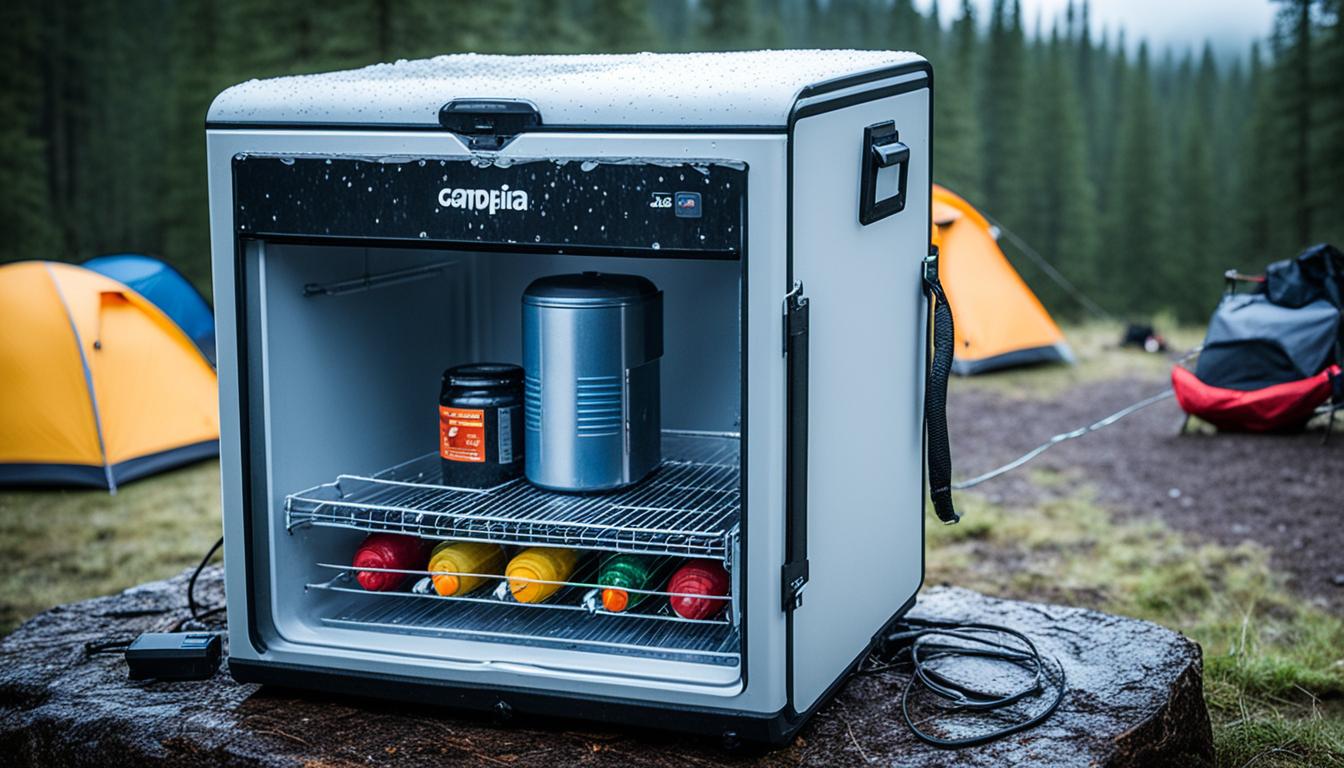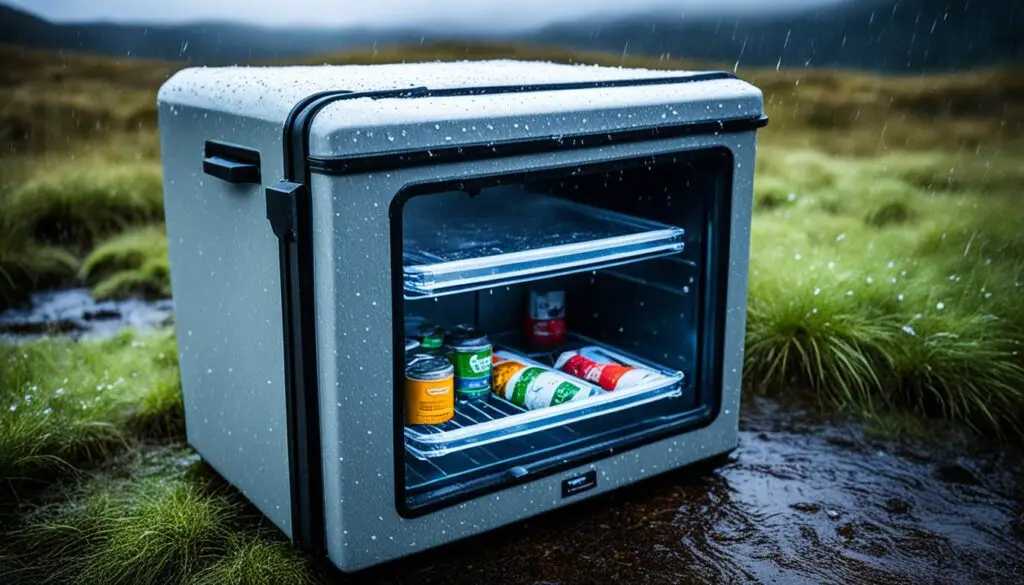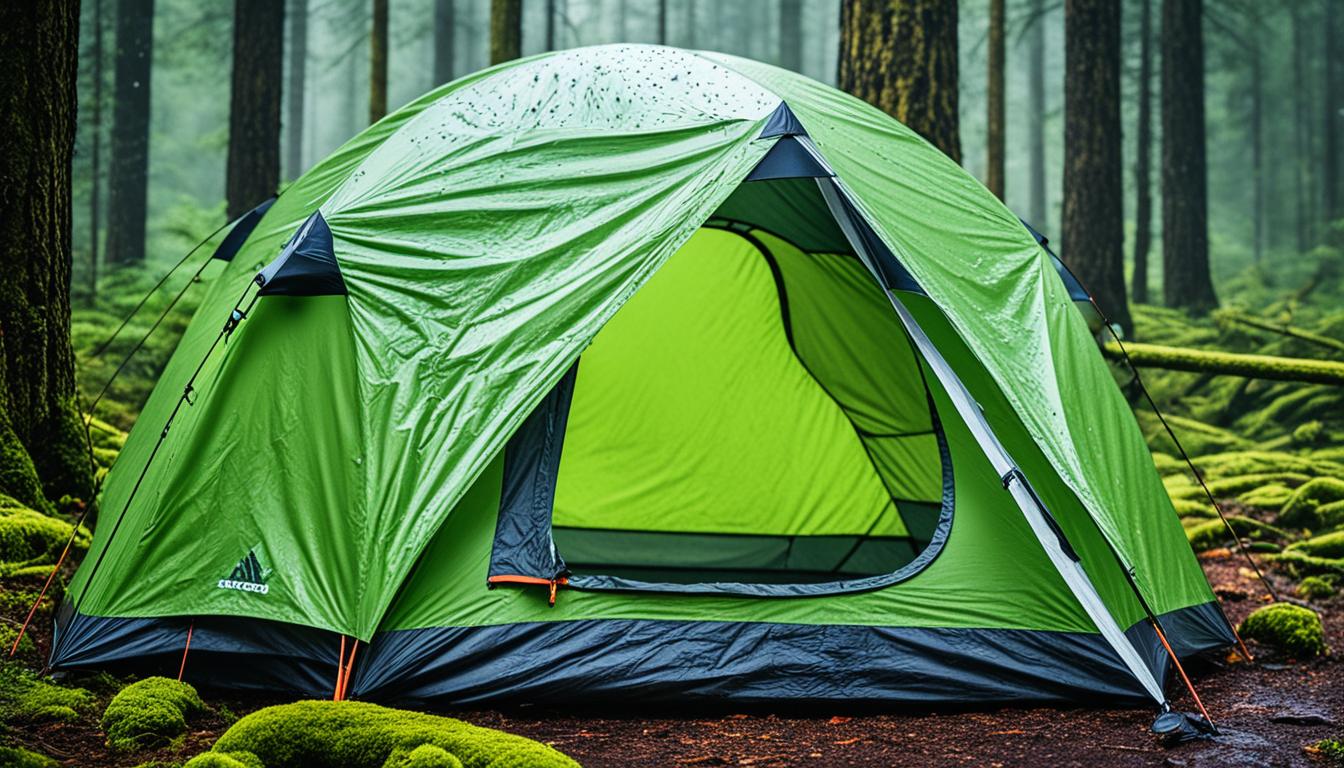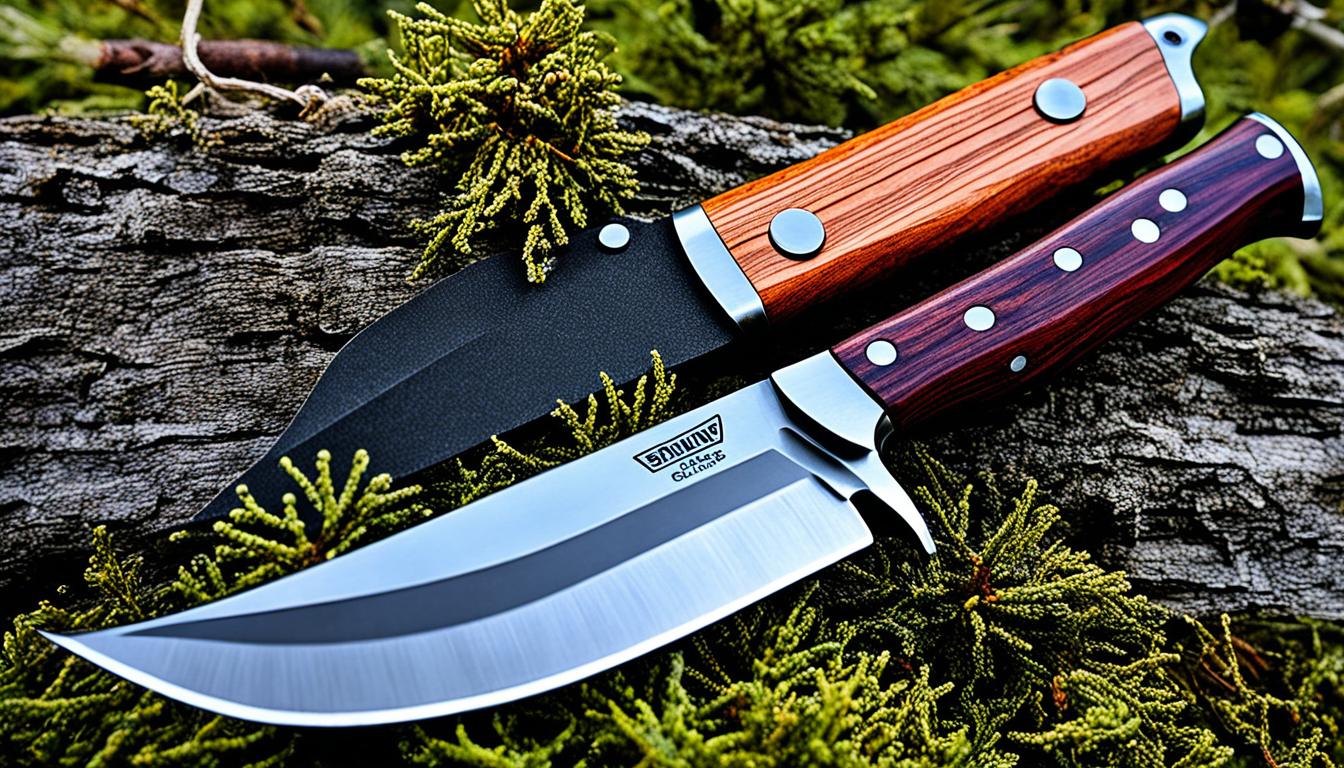
As someone who loves the outdoors, I know how important it is to take good care of your gear. This is very true for camping refrigerators. The thought of these fridges getting wet worries many. Water can damage their working and life span. In this piece, I’ll dig into if they can handle water and give tips on keeping them dry. This will help ensure your fridge works well even in wet weather.
It’s key to keep your camping fridge in great shape. This way, your food stays fresh no matter where you are. Be it on a hike or at the beach. Knowing if your fridge can deal with water is crucial. It lets you plan better and make sure your gear lasts longer.
Understanding the Risks of Water Exposure
Knowing the difference between water-resistant and waterproof is key for your camping fridge. They affect how well your fridge works around moisture.
Water Resistance vs. Waterproof
Water-resistant fridges can handle light water. But, they shouldn’t be put in heavy rain or submerged. Waterproof fridges, however, can be fully soaked without issue.
Potential Consequences of Water Damage
Water can severely damage a camping fridge. It may cause electrical problems, rust, and bad insulation. This could make the fridge stop working or even be unsafe.
Understanding your fridge’s water resistance or waterproof levels is crucial. It helps avoid water damage and keeps your fridge working well.
Factors Affecting Water Resistance in Camping Fridges
Choosing a camping fridge able to handle water exposure depends a lot on its build and design. We’ll look at the main elements that make these fridges secure against water.
Construction Materials and Design
The materials used are key in deciding how well a camping fridge resists water. Camping fridge construction mixes waterproof and water-resistant stuff. This mix ensures the inside stays safe. Manufacturers use tough, water-resistant materials like strong plastics, stainless steel, and special seals for a tight fit.
Another key point is the IP rating. IP stands for Ingress Protection. This rating shows how well a fridge keeps out solid stuff and water. Fridge models with higher IP ratings, like IP54 or IP65, resist water better. They’re good against splashes, rain, or even brief underwater moments.
| IP Rating | Protection Against Solid Objects | Protection Against Water |
|---|---|---|
| IP54 | Protected against dust, limited ingress | Protected against water splashes from any direction |
| IP65 | Dust-tight, no ingress of dust | Protected against low-pressure water jets from any direction |
The fridge’s design adds to its water-blocking powers. Things like sealing gaskets, drains, and strong casing help. Makers think carefully about these features to make sure their fridges are tough for outdoor fun.
Knowing about the materials and design helps you pick a fridge that keeps your food safe from wet outdoor experiences.
Can Camping Fridges Get Wet?
Camping fridges are often used outdoors, so water exposure is a major concern. The outdoors is wet and weather is unpredictable. Many campers wonder if their fridges can handle being wet.
Yes, camping fridges can get some water on them without harm, depending on their design. Some are very water-resistant or even waterproof. But, you must be careful of how much water they get exposed to.
Factors Influencing Water Resistance in Camping Fridges
A camping fridge’s water resistance depends on the materials used and how it’s built. Fridges with strong, sealed parts and good gaskets are more likely to resist water. The quality of the seals and the cooling system is also crucial.
| Camping Fridge Feature | Water Resistance Level |
|---|---|
| Rugged, sealed exterior | High |
| Lightweight, porous materials | Low |
| High-quality seals and gaskets | High |
| Integrated cooling system | High |
Even if your camping fridge is well designed, it still might not be 100% waterproof. Too much water or being fully submerged can harm it.
Know your fridge’s water resistance levels and protect it as needed. This will help keep it working well and lasting longer.

Protecting Your Camping Fridge from Moisture
It’s important to keep your camping fridge working well. Moisture can harm it. But, there are ways to keep your fridge dry and performing well, even in wet conditions.
Waterproof Covers and Cases
Using waterproof accessories like covers is a smart move. These products help keep your fridge dry. Look for covers made of durable material. This ensures they last through rough outdoor use.
Proper Storage and Transportation
How you store and move your fridge matters too. Keep it in a dry place when you’re not using it. And make sure it’s well-ventilated.
When transporting your fridge, stop it from moving around. This stops it from getting wet from puddles or rain.
By following these steps, you can keep your camping fridge safe from moisture. This way, it will be ready for all your outdoor trips. Plus, you’ll avoid expensive fixes in the future.
Dealing with Wet Camping Fridges
Drying Out and Cleaning Procedures
If your camping fridge gets wet, there’s no need to panic. With the right steps, you can make it good as new. Let’s look at how to dry and clean a damp fridge.
First, unplug your fridge and take out all wet items. This stops more damage and helps it dry. Use a dry cloth or paper towels to get rid of extra water. Be careful not to wipe too hard. You might push water into the fridge more.
Place the fridge in a spot with lots of air, like outside in the sun or near a fan. This helps moisture disappear. Keep the door open for air to flow. The drying out might take a few hours or a couple of days.
- Look inside and outside the fridge for water damage or rust. Check the seals and any electrical parts closely.
- If you see any harm, it’s smart to change these parts before using the fridge again. If you’re not sure how, ask for help.
- After the fridge is dry, clean it with a soft cloth and a gentle cleaner. Avoid strong chemicals. They can harm the fridge.
- Make sure everything is completely dry before you put the fridge back together and turn it on.
If the fridge was under water for a long time, it might have hidden damage. In these cases, a pro check-up is a good idea. They can ensure it will work safely for you.
Following these steps will help you fix your wet camping fridge. This way, you’re ready for more adventures. Keep it dry by using waterproof covers or cases. This can prevent wet accidents in the future.
Choosing the Right Camping Fridge
When you pick a camping fridge, think about what you’ll need for outdoor trips. The right fridge will keep your food and drinks fresh, even in any weather conditions.
First, check if the fridge is good against water and how tough it is. Get one that is made to handle water and is tough. Look for gasket seals, strong build, and IP ratings for water and dust protection.
- Water Resistance Rating: Look at the IP rating to see how well it resists water and dust. Aim for at least IP54 to protect it from splashing water.
- Robust Construction: A fridge made from strong materials can survive the outdoor use better.
- Airtight Seals: Gasket seals stop water from coming in and keep the cool air inside.
Think about the size, how much it can hold, and the power it needs. Bigger fridges hold more but can be heavy and need more power. Smaller, lighter fridges are easier to move and still cool well.
| Feature | Importance for a Water-Resistant Camping Fridge |
|---|---|
| Water Resistance Rating | Keeps the fridge safe from water and harsh weather |
| Construction Materials | Strong materials protect the fridge from water damage |
| Airtight Seals | Keeps the inside cool and the water out |
| Size and Capacity | Decides the fridge’s ability to hold things, how easy it is to move, and the power it needs |
Choosing the right camping fridge is crucial for fresh, cool drinks on your outdoor trips, no matter the weather.
Conclusion
We explored the big issue of water’s effect on camping fridges. We looked at the risks between water-resistant and waterproof fridges. Also, we talked about what affects how well fridges keep out water. This info helps you choose wisely when protecting your outdoor gear.
It’s crucial to know how well your fridge stops water and to act early to keep it dry. You can do this with waterproof covers, cases, and safe storage ideas. Doing so will help your fridge last, even when outdoors gets tough.
As you head out for your next camping trip, keep in mind what you’ve learned here. Make sure your camping fridge is safe, so your adventure goes smoothly. Even if it rains or you spill something, your food and drinks will stay fresh. So, prepare well and enjoy camping without worry.
FAQ
Can camping fridges get wet?
Yes, camping fridges can get wet. How well they handle water varies by their build. Some are made to resist water. But, others might need protection to avoid water damage.
What are the potential consequences of water damage to a camping fridge?
Water damage in a camping fridge can cause several problems. These include electrical issues, rust, and weak insulation. Such issues can make the fridge not work as it should, affecting the food inside.
How can I protect my camping fridge from moisture?
To keep your fridge dry, use waterproof covers. Also, remember to store and carry it carefully. A fridge with a high IP (Ingress Protection) rating is a great choice for water resistance.
What should I do if my camping fridge gets wet?
If your fridge gets wet, dry it well and clean it. Taking it apart to clean inside is wise. Then, let it dry completely before using it again.
What factors should I consider when selecting a water-resistant camping fridge?
When buying a camping fridge, look at the materials and design. A high IP rating means better waterproofing. Choose a model designed to keep water out during your outdoor trips.
- Discover the 4 Must-Have Camping Tent Accessories for Spring 2025 - March 19, 2025
- Why Camping Is Bad - November 29, 2024
- Best Camping Knife - November 29, 2024






